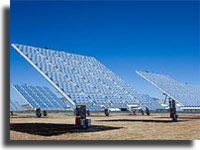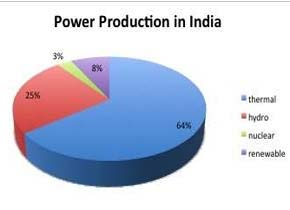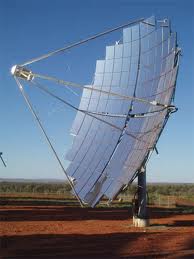| Size of the Industry | Total Installed capacity of 144912 MW. Over 5,000 trillion kilowatts of solar energy in a year. The average intensity of solar radiation received on India is 200 MW/km square |
| Geographical distribution | Delhi, Uttar Pradesh, West Bengal, Maharashtra and Chandigarh, Gujarat and Rajasthan |
| Output per annum | Total installed renewable energy of India's currently total installed renewable energy stands at 13,242.41 MW as per MNRE |
| Percentage in world market | India Consumes 3.7% of the world's commercial energy making it has the 5th largest consumer of energy globally |
| Market Capitalization | The number of solar water heating systems is projected to grow at a CAGR of about 22% between 2011 and 20 |

Today with growing advancement and pace of development India needs more power. Not only to cover its daily power shortfalls (several hours per day), but also to support its economic development. In 2008 According to CEA, the peak demand was 120 gigawatts of power, while only 98 gigawatts could be supplied. According to an analysis by the Indian PV project developer Astonfield, quoting the President of India Energy Review, this deficit is likely to grow to 25 gigawatts by 2012. The targeted share of renewable energy is 24% for 2031, with the amount of solar energy increasing to 56 gigawatts of installed power.

Speaking of big numbers and energy consumption: every month 8-10 million new mobile phones are connected in India. This is an interesting market segment for solar PV as well: thousands of new GSM poles will be needed across the country. In 1976 The Solar Energy of India (SESI), established having its Secretariat in New Delhi is the Indian Section of the International Solar Energy Society (ISES). All aspects of renewable energy, including characteristics, effects and methods of use are covered and it provides a common ground to all those concerned with the nature and utilization of this renewable non-polluting resource. With the distribution of 10 million solar lanterns in remote areas and to nomadic populations, India could save 500 million litres of kerosene a year.

The potential customers of Solar Energy installation fall into these categories:
- Residential clusters or the "colonies" in India. There is a strong sense of community among the colonies of urban and suburban.
- Business office complexes - Companies such as IBM, EMC, Intel, Pfizer, etc. have built immense office complexes in the last 5-8 years that house
- Thousands of employees and huge arrays of power-hungry computer equipment.
- Rural townships and villages - it is an immense market and would typically be government-funded or non-profit funded installations. A target for electrifying 5,000 such villages was fixed for the Tenth National Five Year Plan (2002-2007).
- Individual Residences are good significant number of private citizens who are in a position to afford solar power installations e.g. being "green."
- Large government power production facilities - on 1- to 5-MW power plant facilities as well as its larger goals for upgrading India's overall power production.
- Water-pumping is unpredictable and inconsistent costs of Monsoon-based farming are a detriment to farmers in these areas...
 |
The Indian Solar Energy sector has been growing rapidly, in the past few years, majorly due to Governments initiatives such as tax exemptions and subsidies. Due to technical potential of 5,000 trillion kWh per year to minimize the operating cost, Solar Power is considered the best suited energy source for India. Today the Solar power has an installed capacity of 9.84 MW which is about less than 0.1%, currently total installed renewable energy stands at 13,242.41 MW as per MNRE. |
Solar-based energy today accounts for only 0.5% of that number with a grid-interactive (grid-hybrid) solar power totaling only 2.12 MW from just 33 such installations.
The Indian Gross Domestic Product (GDP) is targeted to grow at 8% over the next ten years. At this rate, power demands may rise from the present 120 GW to 315-335 GW by 2017. Consumer demand is growing at 14% over the next 10 years - faster than the GDP rate!
- India recently had opened tenders for 500 MW of Photovoltaic Solar Energy with 5 MW being the fixed size of a plant. Government has got bids for 10,000 MW or 20 times the amount to be bid according to he recent reports. This implies that the PV portion of the Phase 1 of JNNSM will go for discount bidding. In layman terms it means that the projects will be awarded to companies willing to build the plants at a discount to the CERC mandated FIT rate of Rs 17.91/KwH.
- As the Indian government has announced the incentives for manufacturing solar cells and panels earlier this year, it has targeted meeting 10 % of the country's power needs through renewable energy by 2012.
- Tata BP Solar, a joint venture between the Tata Group of India and BP Solar of the United Kingdom, operates one of the oldest solar-energy equipment manufacturing plants in India, near Bangalore which would be expanded now, at an additional investment of $100 million.
- India is ranked 7th worldwide for solar photovoltaic (PV) cell production and secure 9th rank in solar thermal power generation. Indian Solar capacity is growing rapidly due to the entry of various private players in manufacturing of solar energy equipment. According to analyst and scientists the Indian solar energy sector is estimated to grow at 25% year on year in next few years.
- Jawaharlal Nehru National Solar Mission (JNNSM) in 2022 the Target of 20GW of Solar Power. The current installed capacity is only 9500 MW which gives vast opportunity for exploitation of renewable energy sources Indian Government is striving hard to push the solar power industry to make India a global leader by introducing grid based incentives and concessions in various duties in the recent budget (2010-11)
 Recent Press Release
Recent Press Release
 INDIAN Solar Industry AT A Glance IN 2021 - 2022
INDIAN Solar Industry AT A Glance IN 2021 - 2022
 INDIAN Solar Industry AT A Glance IN 2020 - 2021
INDIAN Solar Industry AT A Glance IN 2020 - 2021
 INDIAN Solar Industry AT A Glance IN 2019 - 2020
INDIAN Solar Industry AT A Glance IN 2019 - 2020
 INDIAN Solar Industry AT A Glance IN 2018 - 2019
INDIAN Solar Industry AT A Glance IN 2018 - 2019
 INDIAN Solar Industry AT A Glance IN 2017 - 2018
INDIAN Solar Industry AT A Glance IN 2017 - 2018
 INDIAN Solar Industry AT A Glance IN 2016 - 2017
INDIAN Solar Industry AT A Glance IN 2016 - 2017
 INDIAN Solar Industry AT A Glance IN 2015 - 2016
INDIAN Solar Industry AT A Glance IN 2015 - 2016
 INDIAN Solar Industry AT A Glance IN 2014 - 2015
INDIAN Solar Industry AT A Glance IN 2014 - 2015
 INDIAN Solar Industry AT A Glance IN 2013 - 2014
INDIAN Solar Industry AT A Glance IN 2013 - 2014
 INDIAN Solar Industry AT A Glance IN 2012 - 2013
INDIAN Solar Industry AT A Glance IN 2012 - 2013
 INDIAN Solar Industry AT A Glance IN 2011 - 2012
INDIAN Solar Industry AT A Glance IN 2011 - 2012
Indian Industries
 |
INDIAN INDUSTRIES |



 INDIAN SOLAR INDUSTRY
INDIAN SOLAR INDUSTRY